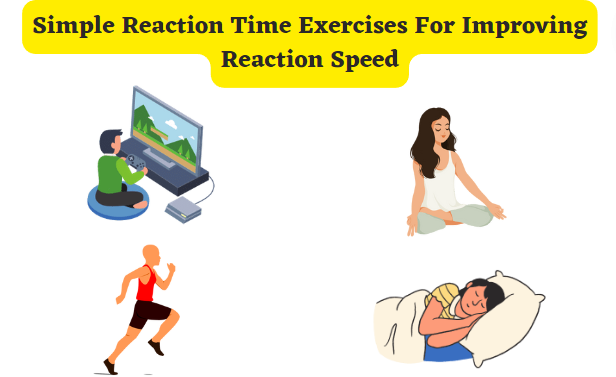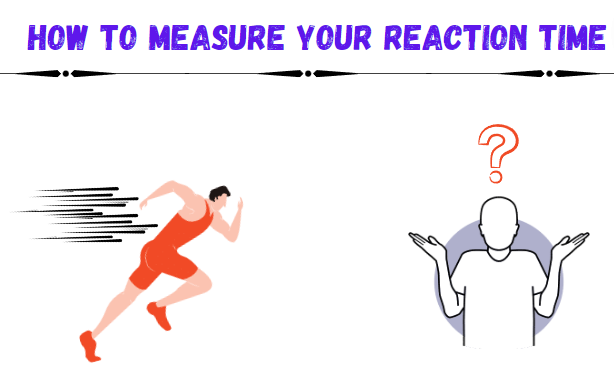
When I started taking physical fitness more seriously, I didn’t think of reaction time exercises. Like many others, I would strive to improve flexibility, toning, and endurance.
But without good reaction time, your active lifestyle has an expiration date. Not only does reaction time determine your success as an athlete, but it helps us prevent injury.
I found this out the hard way on a hike. I saw loose rocks begin to move under my partner’s feet just ahead but failed to get my bearings in time.
Ultimately, improved reaction time is the difference between a seriously sprained ankle and a successful hike.
Learning what affects reaction time, as well as what reaction time really is (it is NOT your reflexes!) can make you much more capable overall. On the tennis court or weight bench, how you react is everything.
Want to optimize your performance? Keep reading my deep dive into reaction time.
What Is Reaction Time?
When the starting gun goes off, you hear it.
When the ball is coming at you, you see it.
But how quickly does your body respond? And how is it responding? Do you jump, flail, or flinch? Or, do you respond with the precise muscle movements the situation requires?
Reaction time is how quickly you perform in your chosen sport or activity. But several factors go into a successful performance. Let’s look at a few types of reaction times.
Mental Reaction Time
Your mental reaction time is how quickly you perceive something. In my hiking story from earlier, my mental reaction time was just fine. I was alert and perceived the moving rock quickly. However, I needed better physical reaction time.
Physical Reaction Time
Your physical reaction time is how long you take to physically respond to something.
Physical reaction time is not just about moving; it’s about moving with purpose. This is why competitive athletes practice so often.
To be first, to be fastest, you need superior physical reaction time.
Simple Reaction Time
Simple reaction time involves your reaction to a single stimulus. It’s just you versus one object, sound, or person.
Coming up, we’ll measure your simple reaction time.
Complex Reaction Time
Your complex reaction time involves decision-making. Even if your decision isn’t affected, complex reaction time means you have to take other factors into account.
Take for example a soccer player who passes a ball or attempts a goal. They have to consider where other players are and how they may interfere or react to what they do.
What Is The Average Reaction Time?
To improve reaction time, you have to know where you stand. That begins with knowing where everyone else stands.
Average Human Reaction Time
Some research says that the average human reaction time is approximately 250 milliseconds. That is a quarter of a second.
There are a few more things to know about this. One, that reaction time average is based on simple reaction time. One stimulus, one reaction.
(You’ll be tested on this in a minute.)
Two, researchers suggest that 200 of those milliseconds are mental. Only 50 milliseconds is spent on muscle response.
Reaction Time In Sports
Because sports require fast complex reaction times, the “average” is a bit different. The unique situation and the sport itself will determine what is average.
But what really matters is being better than average.
We know that the average muscle response to a single stimulus is 50 milliseconds. Therefore, the difference between being a hero on the field and letting everyone down is a few milliseconds.
This makes the importance of reaction time exercises quite clear.
Difference Between Reaction And Reflexes
The most common misconception about reaction time is that it has anything to do with your reflexes.
In fact, if you asked me a few years ago to measure my reaction time, I might expect that my doctor needed to tap my knee with a little rubber hammer.
This is not the case. Reaction time takes practice. Reflexes are involuntary. In one example, we have a baseball player at bat.
His practice informs his complex reaction time as the pitcher lets the ball go. This will tell him how and when to swing the bat. His reflexes have him squeeze his eyes shut as the ball comes flying directly at his face.
When I sprained my ankle hiking, I reflexively caught the ground with my hand as I fell. I never intended to do that. A good reaction time would have prevented the fall in the first place.
How To Measure Your Reaction Time

I’ll give you two ways to measure your simple reaction time right now – manually or on the internet.
The Ruler Test
All this test takes is a ruler and a partner. Make sure your ruler has centimeter markings on it.
Your partner will stand while you will be seated upright. They will hold the ruler straight down from above. You will be holding out your thumb and forefinger at the end of the ruler marked zero. You’re not touching it but are in a position to catch it.
Your partner releases the ruler without warning. The amount of time it takes to grasp the ruler between your fingers is your reaction time. And since the ruler has distance markings on it, you can use these to estimate your time.
Reaction Test
You can also test your simple reaction time at reaction time tes. You’ll only need to click your mouse as soon as you see the color green. I recommend trying both tests. Reaction time test is fast and easy, but your time can be impacted by your device and internet connection. Either way, I’m sure you’d like to improve your reaction time. Let’s get into exactly how you do that.
Reaction Exercise Drills For Any Sport
If you’re not a competitive athlete, but like to participate in various sports for fun and fitness, start here.
These drills can help you improve not only your speed but your agility. That will serve you well no matter how you like to move your body. All you need to perform these drills are some type of markers – they could be cones, water bottles, anything you can see clearly. You also need a partner.
- Set your markers 20 yards apart. You will be moving between these at three or four different paces. At your partner’s first signal, you will begin a light jog back and forth between the markers.
At random, your partner will tell you to speed up or slow down. This will strengthen your ability to react quickly to auditory cues. - Set your markers 10-20 yards apart. You will be at one marker and your partner at the other. Jog or jostle lightly in place as you await the cue.
When your partner lifts their arms overhead, that’s your signal to move forward. When they put their arms down, that’s your signal to start moving backward toward your marker. This tests your response to visual cues.
Reaction Ball Drills
Coming up, I’ll share a few reaction time exercises that are done with a tennis ball, because I know a lot of you already have those on hand.
However, I strongly suggest looking into a six-sided bouncing ball for your drills. These bounce higher than tennis balls. But more than that, having six sides makes it harder to predict the direction it will bounce.
Because of this challenge, practicing reaction balls drills alone is more effective. For many drills, a partner is only necessary to add unpredictability.
